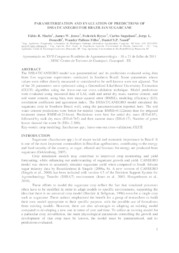Parameterization and evaluation of predictions of DSSAT/CANEGRO for Brazilian sugarcane.
Parameterization and evaluation of predictions of DSSAT/CANEGRO for Brazilian sugarcane.
Author(s): MARIN, F. R.; JONES, J. W.; ROYCE, F.; SUGUITANI, C.; DONZELLI, J. L.; PALLONE FILHO, W.; NASSIF, D. S. P.
Summary: The DSSAT/CANEGRO model was parameterized and its predictions evaluated using data from five sugarcane experiments conducted in Southern Brazil. Some parameters whose values were either directly measured or considered to be well-known were not adjusted. Ten of the 20 parameters were optimized using a Generalized Likelihood Uncertainty Estimation (GLUE) algorithm using the leave-one-out cross-validation technique. Model predictions were evaluated using measured data of LAI, stalk and aerial dry mass, sucrose content, and soil water content, using bias, root mean squared error (RMSE), modeling efficiency (Eff), correlation coefficient and agreement index. The DSSAT/CANEGRO model simulated the sugarcane crop in Southern Brazil well, using the parameterization reported here. The soil water content predictions were better for rainfed (mean RMSE=0.122mm) than for irrigated treatment (mean RMSE=0.214mm). Predictions were best for aerial dry mass (Eff=0.85), followed by stalk dry mass (Eff=0.765) and then sucrose mass (Eff=0.17). Number of green leaves showed the worst fit (Eff=-2.300).
Publication year: 2011
Types of publication: Paper in annals and proceedings
Observation
Some of Embrapa's publications are published as ePub files. To read them, use or download one of the following free software options to your computer or mobile device. Android: Google Play Books; IOS: iBooks; Windows and Linux: Calibre.
Access other publications
Access the Agricultural Research Database (BDPA) to consult Embrapa's full library collection and records.
Visit Embrapa Bookstore to purchase books and other publications sold by Embrapa.

